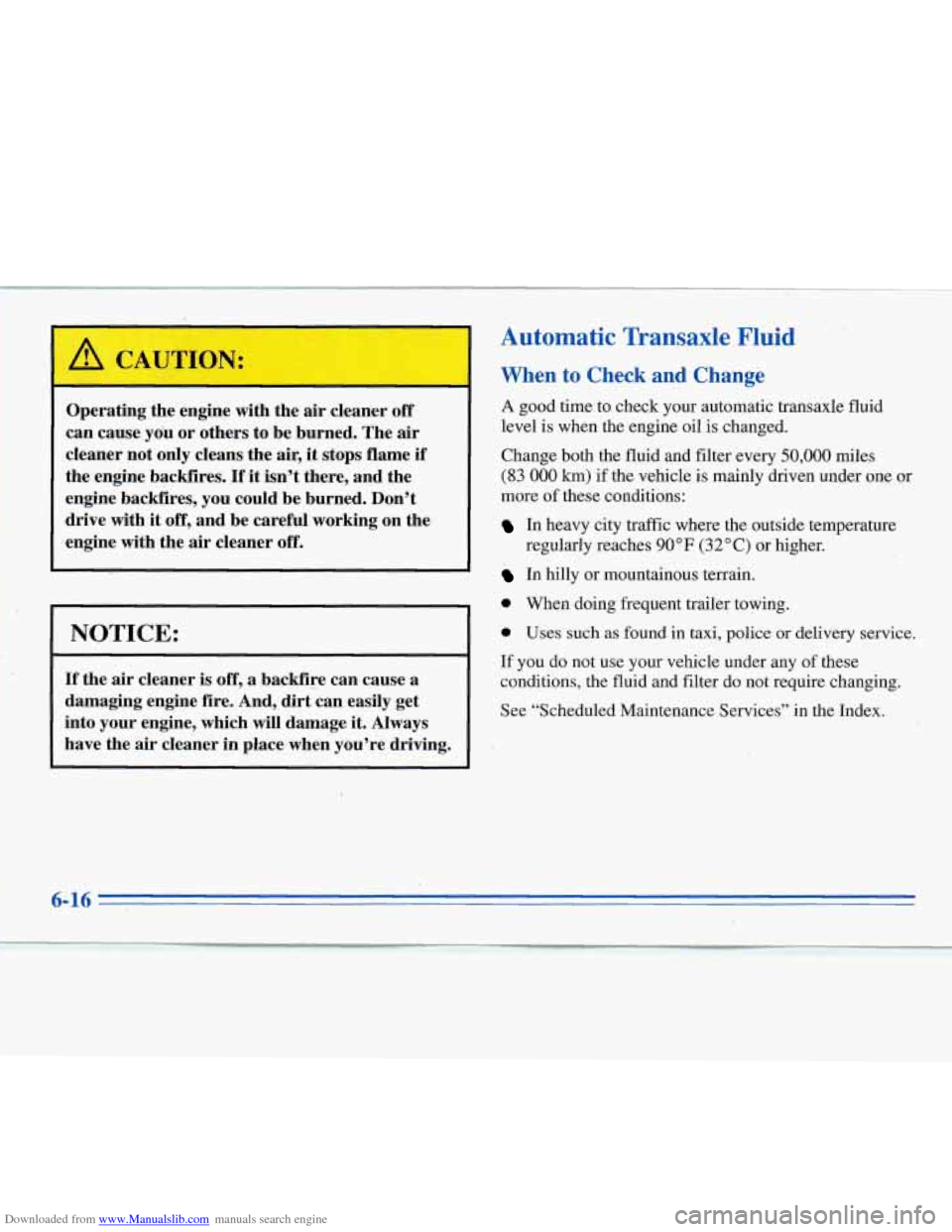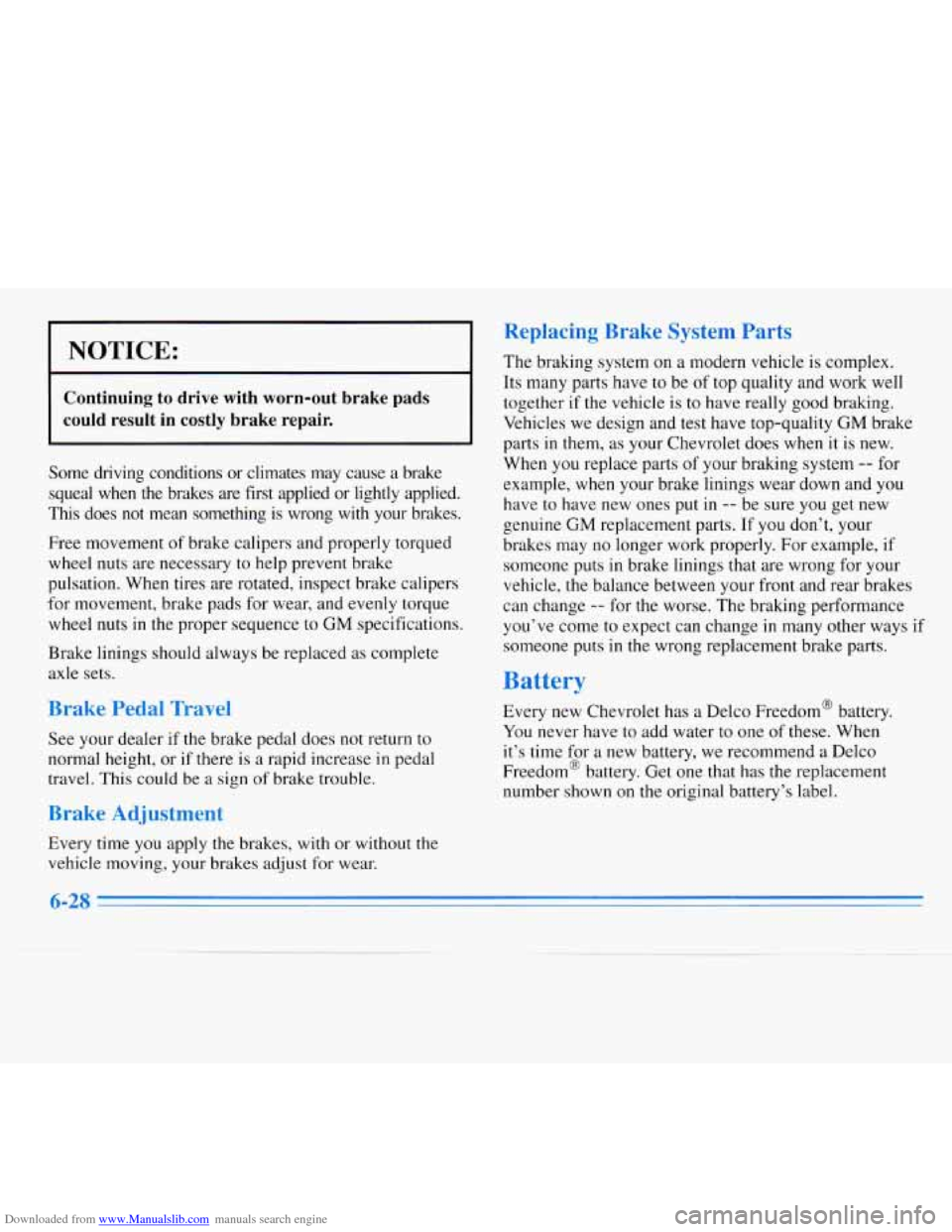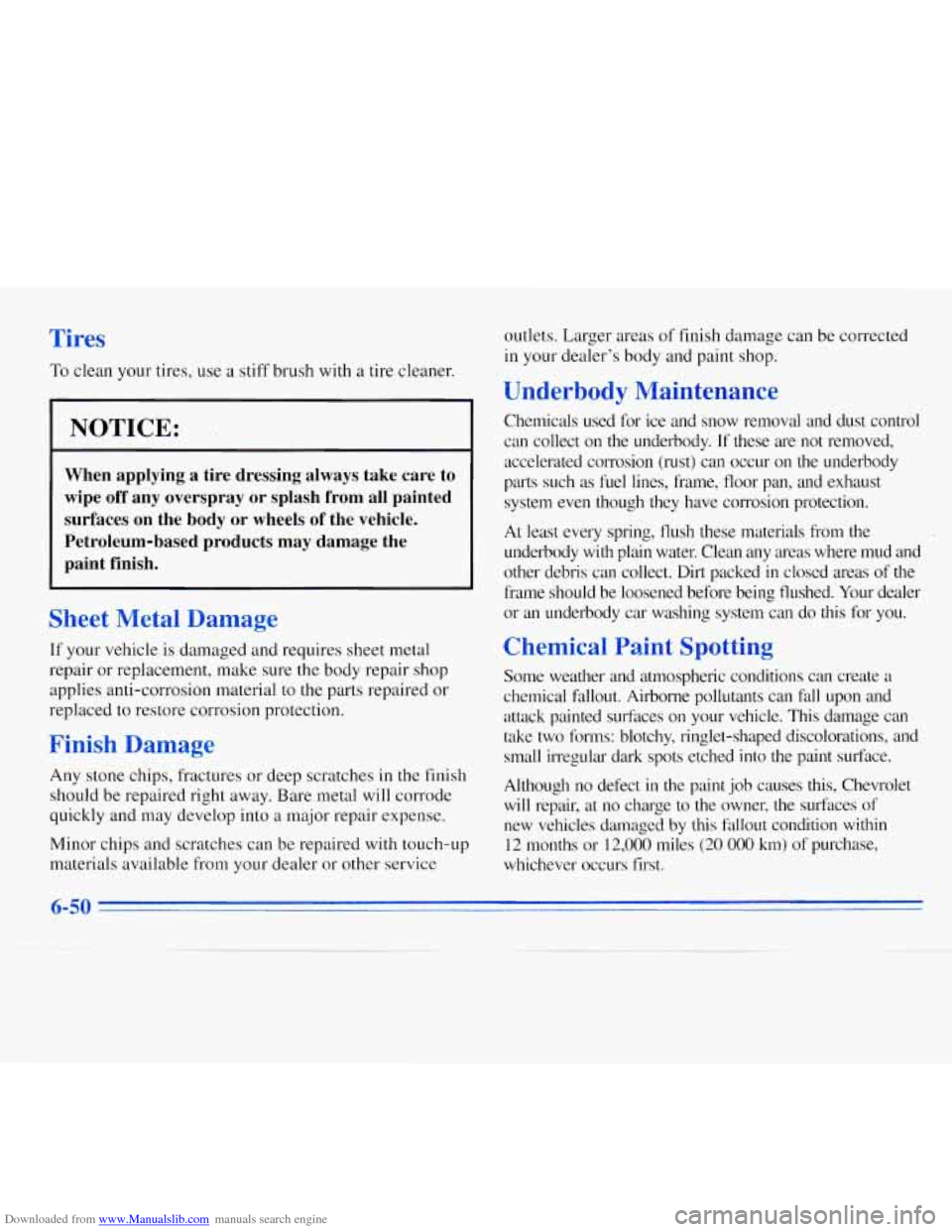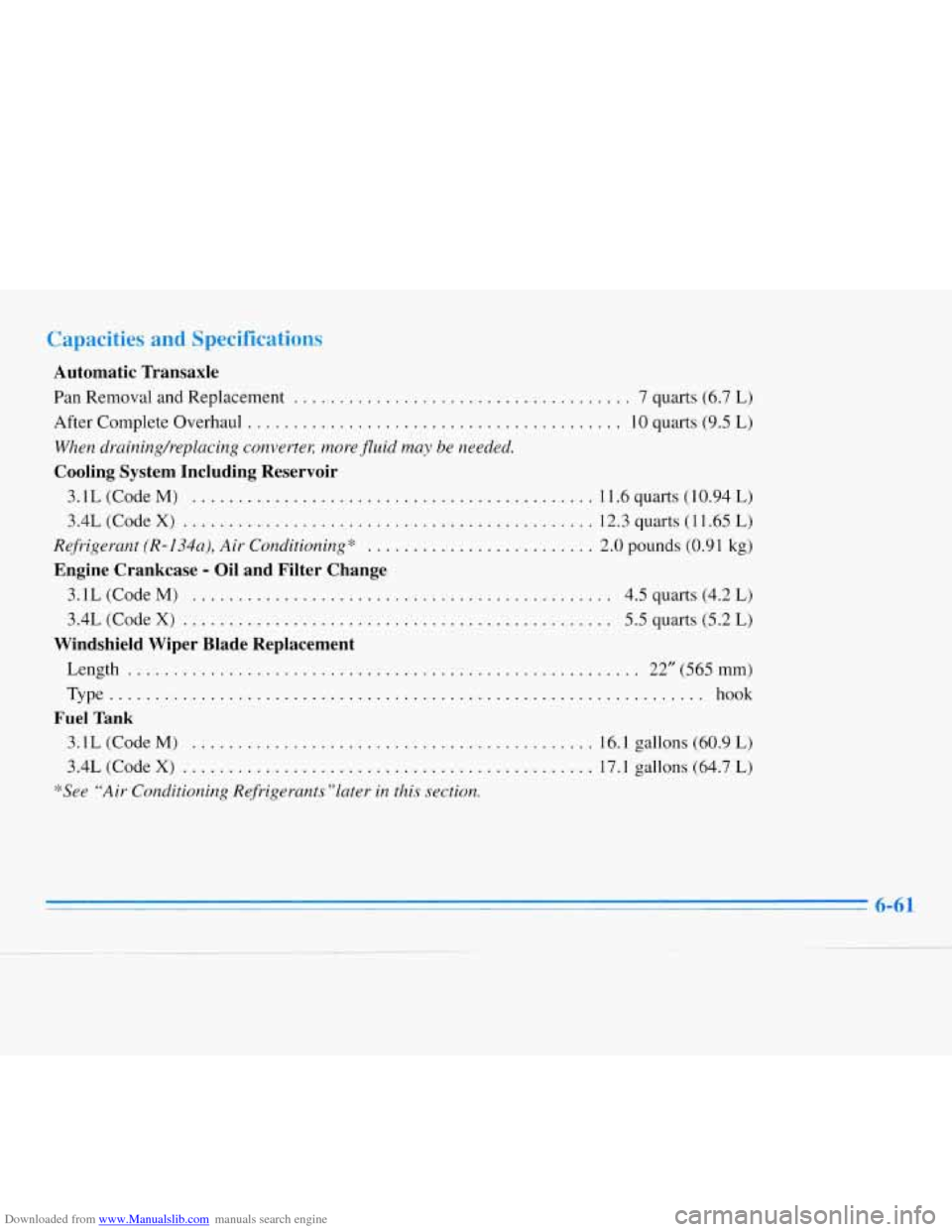1996 CHEVROLET MONTE CARLO air condition
[x] Cancel search: air conditionPage 210 of 340

Downloaded from www.Manualslib.com manuals search engine You can be injured and your vehicle could be
damaged if you try to do service work on a
vehicle without knowing enough about it.
0 Be sure you have sufficient knowledge,
experience, and the proper replacement
parts and tools before you attempt any
vehicle maintenance task.
Be sure to use the proper nuts, bolts and
other fasteners. “English” and “metric”
fasteners can be easily confused. If you use
the
wrong fasteners, parts can later break
or fall off. You could be hurt.
Fuel
Use regular unleaded gasoline rated at 87 octane or higher.
At a.minimum, it should meet specificatiom.ASTM D4814
in the United States and
CGSB 3.5-M93 in Canada.
Improved gasoline specifications have been developed by
the American Automobile Manufacturers Association
(AAMA) for better vehicle performance and engine
protection. Gasolines meting
the AAMA specification
~~~ ~ ~~~
could provide improved driveability and emission control
system protection compared
to other gasolines.
Be sure the posted octane is at least 87. If the octane is
less than 87, you may get a heavy knocking noise when
you drive. If it’s bad enough, it can damage your engine.
If you’re using fuel rated at 87 octane or higher and you
still hear heavy knocking, your engine needs service.
But don’t worry if you hear a little pinging noise when
you’re accelerating or driving up a hill. That’s normal,
and you don’t have to buy a higher octane fuel to get rid
of pinging. It’s the heavy, constant knock that means
you have a problem.
If your vehicle is certified to meet California Emission
Standards (indicated on the underhood tune-up label),
it is designed to operate on fuels that meet California
specifications. If such fuels are not available in states
adopting California emissions standards, your vehicle
will operate satisfactorily on fuels meeting federal
specifications, but emission control system performance
may be affected. The malfunction indicator lamp on
your instrument panel may turn on and/or your vehicle
may fail a smog-check test.
If this occurs, return to your
authorized Chevrolet dealer for diagnosis to determine
the cause of failure. In the event it is determined that the
cause
of the condition is the type of fuels used, repairs
may not be covered by your warranty.
6-2
Page 224 of 340

Downloaded from www.Manualslib.com manuals search engine -
,A CAUTION:
Operating the engine with the air cleaner off
can cause you or others to be burned. The air
cleaner not only cleans the air, it stops flame if
the engine backfires. If it isn’t there, and the
engine backfires, you could be burned. Don’t
drive with
it off, and be careful working on the
engine with the
air cleaner off.
NOTICE:
If the air cleaner is off, a backfire can cause a
damaging engine fire. And, dirt can easily get
into your engine, which will damage it. Always
have the air cleaner in place when you’re driving.
Automatic Transaxle Fluid
When to Check and Change
A good time to check your automatic transaxle fluid
level is when the engine oil is changed.
Change both the fluid and filter every
50,000 miles
(83 000 km) if the vehicle is mainly driven under one or
more
of these conditions:
In heavy city traffic where the outside temperature
In hilly or mountainous terrain.
0 When doing frequent trailer towing.
0 Uses such as found in taxi, police or delivery service.
If you do not use your vehicle under any of these
conditions, the fluid and filter do not require changing.
See “Scheduled Maintenance Services’’ in the Index.
regularly reaches
90°F (32°C) or
higher.
6-16 .
Page 236 of 340

Downloaded from www.Manualslib.com manuals search engine I NOTICE:
Continuing to drive with worn-out brake pads
could result in costly brake repair.
Some driving conditions or climates may cause a brake
squeal when the brakes are first applied or lightly applied.
This does
not mean something is wrong with your brakes.
Free movement
of brake calipers and properly torqued
wheel nuts are necessary to help prevent brake
pulsation. When tires are rotated, inspect brake calipers
for movement, brake pads for wear, and evenly torque
wheel nuts in the proper sequence to
GM specifications.
Brake linings should always be replaced
as complete
axle sets.
Brake Pedal Travel
See your dealer if the brake pedal does not return to
normal height, or if there is a rapid increase
in pedal
travel. This could be
a sign of brake trouble.
Brake Adjustment
Every time you apply the brakes, with or without the
vehicle moving, your brakes adjust for wear.
Replacing Brake System Parts
The braking system on a modern vehicle is complex.
Its many parts have to be
of top quality and work well
together
if the vehicle is to have really good braking.
Vehicles we design and test have top-quality
GM brake
parts in them,
as your Chevrolet does when it is new.
When you replace parts
of your braking system -- for
example, when your brake linings wear down and you
have to have new ones put
in -- be sure you get new
genuine
GM replacement parts. If you don’t, your
brakes may no longer work properly. For example, if
someone puts in brake linings that are wrong for your
vehicle, the balance between your front and rear brakes
can change
-- for the worse. The braking performance
you’ve come to expect can change in many other ways
if
someone puts in the wrong replacement brake parts.
Battery
Every new Chevrolet has a Delco Freedom@ battery.
You never have to add water to one
of these. When
it’s time for
a new battery, we recommend a Delco
Freedom@ battery. Get one
that has the replacement
number shown on the original battery’s label.
6-28
Page 250 of 340

Downloaded from www.Manualslib.com manuals search engine Wheel Alignment and Tire Balance
The wheels on your vehicle were aligned and balanced
carefully at the factory to give you the longest tire life
and best overall performance.
In most cases, you will not need to have your wheels
aligned again. However, if you notice unusual tire wear
or your vehicle pulling one way or the other, the
alignment may need to be reset. If you notice your
vehicle vibrating when driving
on a smooth road, your
wheels may need
to be rebalanced.
Wheel Replacement
Replace any wheel that is bent, cracked, or badly rusted
or corroded. If wheel nuts keep coming loose, the wheel,
wheel bolts and wheel nuts should be replaced. If the
wheel leaks air, replace it (except some aluminum
wheels, which can sometimes be repaired). See your
Chevrolet dealer if any of these conditions exist.
Your dealer will know the kind of wheel you need. Each
new wheel should have the same load carrying
capacity, diameter, width, offset and be mounted the
same way as the one
it replaces.
If you need to replace any of your wheels, wheel bolts
or wheel nuts, replace them only with new
GM original
equipment parts. This
way, you will be sure to have the
right wheel, wheel bolts and wheel nuts for your
Chevrolet model.
CAUTION:
Using the wrong replacement wheels, wheel bolts
or wheel nuts on your vehicle can be dangerous.
It could affect the braking and handling
of your
vehicle, make your tires lose air and make you
lose control.
You could have a collision in which
you or others could be injured. Always use
the correct wheel, wheel bolts and wheel nuts
for replacement.
6-42
Page 258 of 340

Downloaded from www.Manualslib.com manuals search engine Tires
To clean your tires, use a stiff brush with a tire cleaner.
NOTICE:
When applying a tire dressing always take care to
wipe off any overspray or splash from
all painted
surfaces on the body or wheels
of the vehicle.
Petroleum-based products may damage the
paint finish.
Sheet Metal Damage
If your vehicle is damaged and requires sheet metal
repair or replacement, make sure the body repair shop
applies anti-corrosion material to
the parts repaired or
replaced to restore corrosion protection.
Finish Damage
Any stone chips, fractures or deep scratches in the finish
should be repaired right away. Bare metal will corrode
quickly and may develop into
a major repair expense.
Minor chips and scratches can be repaired with touch-up
materials available from your dealer or other service outlets.
Larger areas of finish damage can be corrected
in your dealer’s body and paint shop.
Underbody Maintenance
Chemicals used for ice and snow removal and dust control
can collect on the underbody. If these are not removed,
accelerated corrosion (lust) can occur on the underbody
parts such as fuel lines, frame, floor pan, and exhaust system even though they have corrosion protection.
At least every spring, flush these materials from the
underbody with plain water. Clean
any areas where mud and
other debris can collect. Dirt packed
in closed areas of the
frame should be loosened before being flushed. Your dealer
or an underbody car washing system can do this for you.
Chemical Paint Spatting
Some weather and atmospheric conditions can create a
chemical fallout. Airborne pollutants can
fdl upon and
attack painted surfaces
on your vehicle. This damage can
take
two forms: blotchy, ringlet-shaped discolorations, and
small irregular dark spots etched into the paint surface.
Although no defect
in the paint job causes this, Chevrolet
will repair, at no charge to the owner, the surfaces of
new vehicles damaged by this fallout condition within
I2 months or 12,000 miles (20 000 kin) of purchase,
whichever occurs first.
6-50
Page 268 of 340

Downloaded from www.Manualslib.com manuals search engine Replacement Bulbs
Exterior Lamps Bulb Number
Back-up ............................... 3057
Center High-vounted Stop
............... 89 1 T2
Front Parking/Turn Signal ............... 3357NA
Headlamp. High-Beam
................... 9005
Headlamp. Low-Beam .................... 9006
License Plate ............................ 168
Sidemarker. Front
......................... 194
Sidemarker. Rear
......................... 194
Stop/Tail/Turn Signal
..................... 3057
Interior Lamps Bulb Number
Ashtray ................................. 194
Center Instrument Cluster
............. 16 1 or 194
Console Shift Indicator
............ ‘-4 . .,-. 73
Dome
.................................. 561
Door Lock Switch
......................... 73
GloveBox .............................. 194
Heater and Air Conditioning Control
. . T- 1.75, T- 1.5
High-Beam Indicator ...................... 161
Luggage Compartment
.................... 920
Inside Rearview Mirror Reading
............. 192
Side Window Switch
....................... 73
6-60
Page 269 of 340

Downloaded from www.Manualslib.com manuals search engine Capacities and Specifications
Automatic Transaxle
Pan Removal and Replacement ..................................... 7 quarts (6.7 L)
After Complete Overhaul
......................................... 10 quarts (9.5 L)
When drainingheplacing converte< more fluid may be needed.
Cooling System Including Reservoir
3.1L (Code M) ............................................ 11.6 quarts (10.94 L)
3.4L (Codex) ............................................. 12.3 quarts (11.65 L)
Refrigerant (R-134a), Air Conditioning:’: ......................... 2.0 pounds (0.9 1 kg)
Engine Crankcase - Oil and Filter Change
3.1L (Code M) .............................................. 4.5 quarts (4.2 L)
3.4L (Code X) ............................................... 5.5 quarts (5.2 L)
Length ........................................................ 22” (565 mm)
Type ................................................................. hook
Windshield Wiper Blade Replacement
Fuel Tank
3.1L (Code M) ............................................ 16.1 gallons (60.9 L)
3.4L (Code X)
............................................. 17.1 gallons (64.7 L)
*See “Air Conditioning Refrigerants ”later in this section.
6-61
Page 271 of 340

Downloaded from www.Manualslib.com manuals search engine Normal Maintenance Replacement Parts
Air Cleaner Filter
All Engines ........... A 1208C
Battery
3.1L (Code M) ...... 525 CCA
3.4L (Code
M) ...... 690 CCA
3.1L (Code M) ...... PF47
3.4L (Code
X) ....... PF5 1
3.1L (Code M) ...... CV892C
3.4L (Code
X) ....... CV895C
Engine Oil Filter
PCV Valve Radiator Cap
All Engines. .......... RC27
Spark Plugs
3.1L (Code M) ...... AC Type 41 -940
Gap: 0.060” ( 1.52 mm)
3.4L (Code X) ....... AC Type 41-919
Gap: 0.045”
( 1.14 mm)
Vehicle Dimensions
Wheelbase ........... 107.5” (2730 mm)
Tread Width (Front)
.... 59.5” (1 512 mm)
Tread Width (Rear)
.... 59.0” (1500 mm)
Length
.............. 200.7” (5099 mm)
Width
............... 72.5” ( 1842 mm)
Height
............... 53.8” (1 368 mm)
Air Conditioning Refrigeran
Not all air conditioning refrigerants are the same.
If the air conditioning system
in your vehicle needs
refrigerant, be sure the proper refrigerant
is used.
If you’re not sure, ask your Chevrolet dealer.